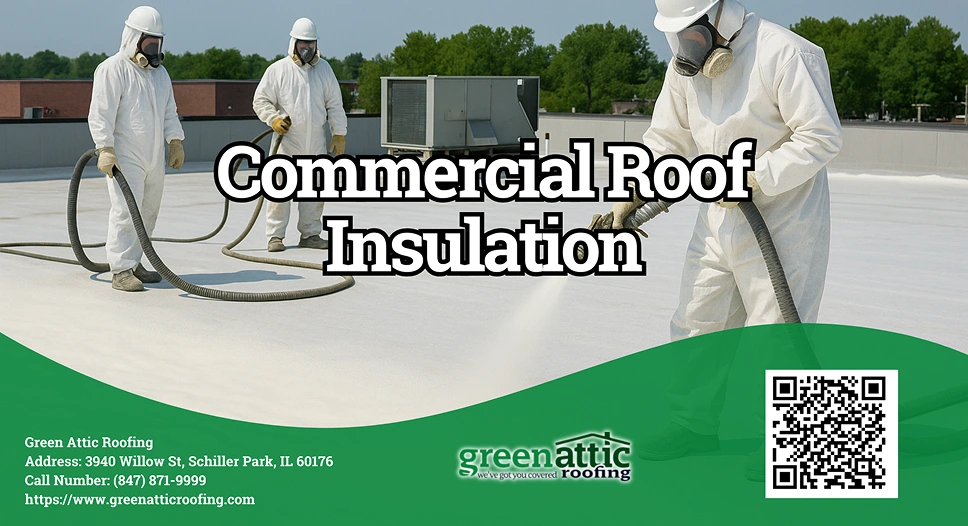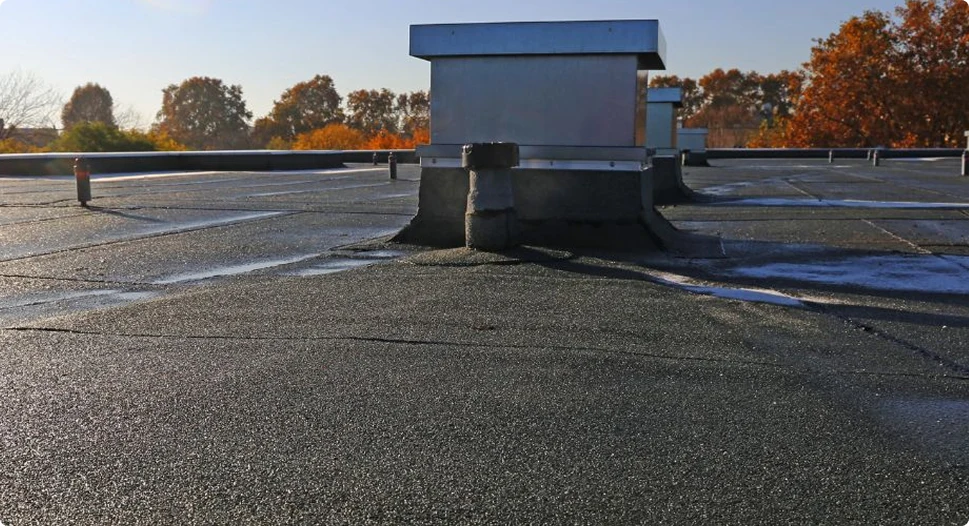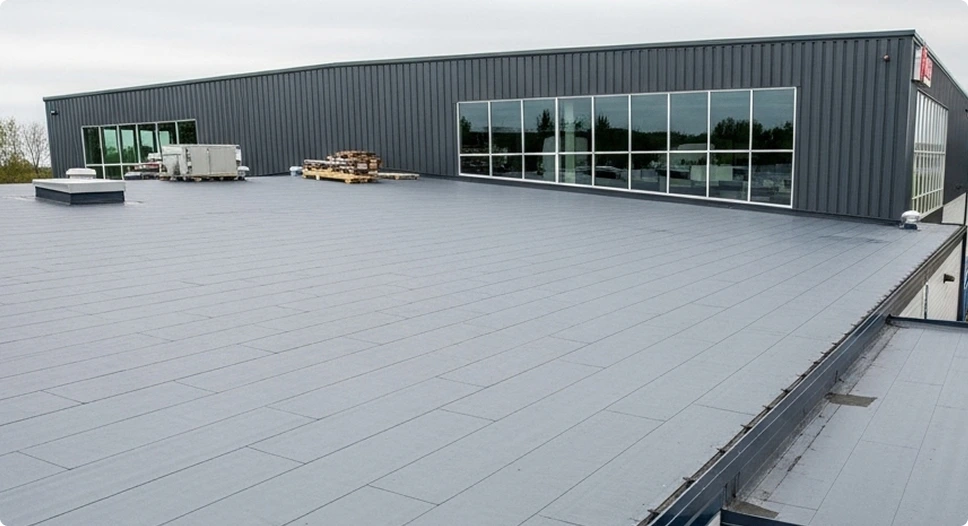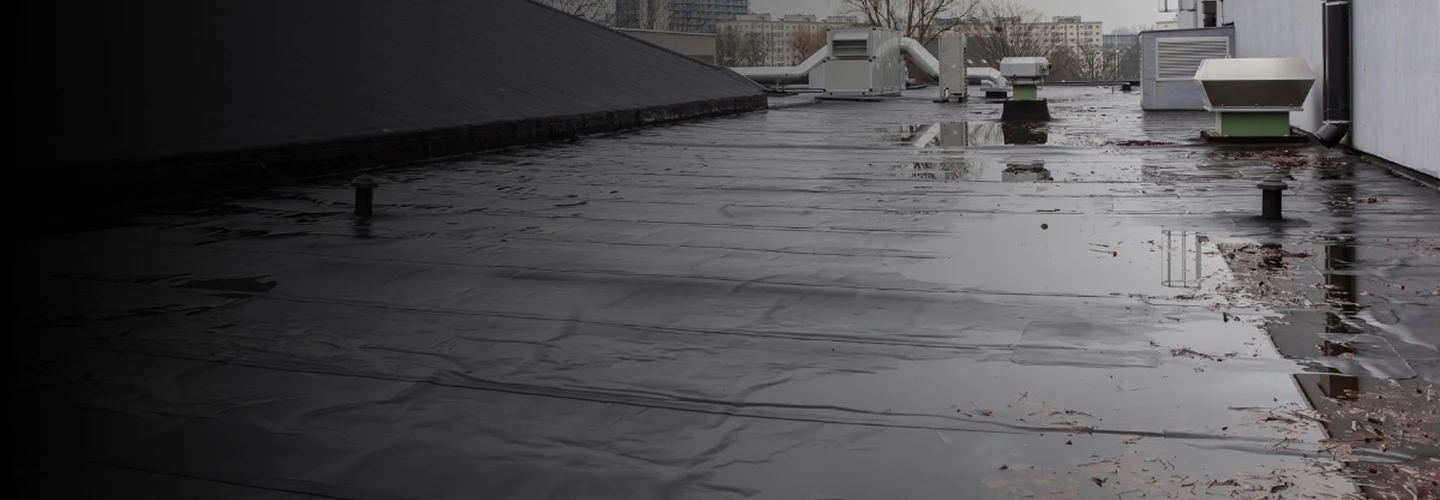Commercial roof insulation serves as a vital thermal barrier, helping regulate indoor temperatures, reduce energy consumption, and improve a building’s overall performance.

Proper insulation enhances HVAC efficiency, extends the lifespan of the roof membrane by mitigating temperature fluctuations, and contributes to meeting building codes and green certifications for commercial buildings.
This comprehensive guide covers the types of insulation products, key benefits, and best practices to help you make informed decisions that improve durability, energy efficiency, and the long-term value of your commercial roofing system.
Key Benefits of Proper Commercial Roof Insulation
Energy Efficiency and Cost Savings
A well-installed thermal barrier minimizes heat transfer, lowering heating and cooling costs.
Enhanced Durability
Effective roof protection systems help shield the membrane from extreme temperatures and weather, extending the roof’s lifespan.
Fire Resistance
Certain materials offer excellent fire-resistant properties, helping contain or slow fire spread.
Soundproofing and Acoustics
A high-quality barrier layer can help reduce external noise, enhancing the building’s acoustic comfort.
Improved Indoor Air Quality
Insulation mitigates moisture buildup, reduces the risk of mold, and helps maintain healthier indoor air quality.
The Role of Insulating Materials in Energy Efficiency and Building Performance
Effective insulating materials support the building envelope by reducing heat transfer and improving energy performance.
Systems with high R-value boards contribute to HVAC efficiency, prevent condensation, and reduce the building’s carbon footprint.
Common Types of Commercial Roofing Insulation Materials: Pros and Cons
This section outlines the most common non-residential roofing insulation products, helping you compare their advantages, limitations, and best-fit applications.
Polyisocyanurate (Polyiso or ISO Board)
Polyiso (polyisocyanurate) is a rigid foam insulation board with glass-fiber facers, known for its superior R-value and energy efficiency.
It is widely used in new construction and roof replacement for its strong balance of heat resistance, durability, and cost-effectiveness.
Polyiso insulation is preferred by industry professionals for its superior energy performance, helping buildings meet energy codes with less material thickness compared to other insulation materials.
It aligns with standards set by the Polyisocyanurate Insulation Manufacturers Association (PIMA).
Manufactured without ozone-depleting blowing agents, polyisocyanurate also supports LEED certifications and green building goals.
Key Advantages:
High R-value per inch: Provides excellent heat resistance with less material thickness.
Fire resistance: Enhances safety and meets non-residential roofing standards.
Long-term durability: Performs well in demanding environmental conditions.
Compatibility: Suitable for TPO, EPDM, PVC, BUR and modified bitumen.
Considerations:
While the initial cost may be higher than other materials, it often delivers greater long-term value through energy efficiency and durability.
Thermal performance remains strong in most climates, with minimal impact in extremely cold environments.
Common Applications:
Flat industrial roofs requiring high-performance insulation.
Suitable for use with:
- Built-Up Roofing (BUR)
- Modified Bitumen Systems
- Metal Roofing Systems
- Single-Ply Membranes (TPO, EPDM, PVC)
Functions as both continuous insulation and as a cover board for added durability and protection.
Available Types:
Standard boards: Deliver reliable continuous insulation, helping achieve energy efficiency goals across most non-residential roofing.
Tapered boards for drainage: Efficiently create slope on low-slope roofs, guiding water toward drains to help prevent ponding and extend roof life.
High-Density Cover Boards: Provide additional durability, enhanced fire resistance, and protection against foot traffic and environmental wear.
Extruded Polystyrene (XPS)
Extruded Polystyrene is a rigid foam board recognized for its consistent heat resistance, excellent moisture resistance, and high compressive strength.
It is a trusted choice, especially in areas where moisture protection and long-term durability are essential.
Key Advantages:
- Strong moisture resistance
- High compressive strength
- Consistent performance over time
- Lightweight and easy to install
Considerations:
- Offers moderate energy efficiency compared to ISO board.
- Achieves reliable performance when used with approved adhesives and solvents.
Expanded Polystyrene (EPS)
Expanded Polystyrene (EPS) is a lightweight, rigid foam board insulation known for its affordability and ease of installation.
While offering moderate heat resistance, it remains a popular choice for budget-conscious and weight-sensitive applications.
Key Advantages:
- Cost-effective solution
- Lightweight and easy to install
- Moderate heat resistance for standard roofing needs
- Basic moisture resistance
Considerations:
- Offers a lower R-value compared to some materials but remains suitable for specific applications.
- Performs well in typical environments, with extruded polystyrene offering superior moisture resistance where required
- Ideal for enclosed or protected settings where exposure to harsh conditions is limited.
Common Applications:
- Budget-conscious roofing projects
- Lightweight structural fill
- Below pavements, geofoam applications
- Roofing in non-critical areas
Spray Polyurethane Foam (SPF)
Spray Polyurethane Foam (SPF) is a liquid-applied solution that forms a durable, seamless, and continuous layer for superior protection.
SPF is valued for its superior air sealing, moisture resistance and outstanding performance.
Key Advantages:
- Stable R-value and air-sealing capability
- Excellent moisture resistance
- Adds structural strength
- Seamless application eliminates heat transfer points
Considerations:
- Higher initial cost
- Requires professional installation
- Proper ventilation is necessary after application
Common Applications:
- Irregular roof shapes
- Retrofits and new builds
- Areas needing airtight seals
Mineral Wool
Mineral Wool is a durable and reliable fibrous insulation material made from natural rock or slag.
It is known for its excellent fire resistance, soundproofing and moderate thermal performance.
Key Advantages of Mineral Wool Insulation:
- Fire-resistant (non-combustible)
- Strong acoustic performance
- Resists mold and pests
- Provides good thermal protection
Considerations:
- Heavier than foam-based alternatives
- Lower R-value per inch compared to ISO Board
Common Applications for Mineral Wool:
- Industrial buildings
- High-rise applications prioritizing fire safety
- Acoustic control needs
Cellular Glass (Foam Glass)
Cellular Glass (Foam Glass) is a robust and dependable rigid insulation made from sealed glass cells.
Known for its moisture resistance and fireproof qualities, it is ideal for demanding environments.
Key Advantages of Cellular Glass Insulation:
- Superior moisture resistance
- Non-combustible fireproof properties
- Dimensionally stable under temperature changes
- High compressive strength
Considerations:
- Higher cost than many other materials
- Brittle compared to other rigid boards
Common Applications for Cellular Glass:
- Building envelopes
- Industrial piping and tanks
- Green roof systems
- Moisture-prone environments
Fiberglass Insulation
Fiberglass insulation consists of fine glass fibers and is widely used for its affordability, acoustic benefits, and fire-resistant properties.
Easily installed in a variety of forms, including batts, rolls, or loose-fill.
Key Advantages:
- Cost-effective
- Good thermal performance
- Excellent fire resistance
- Reduces sound transmission
Considerations:
- Lower R-value per inch compared to foam boards
- Susceptible to moisture if not properly protected
Common Applications:
- Beneath roofing panels
- Attics and between rafters
- Pre-engineered buildings
- Areas needing acoustic control
Comparison of Commercial Roof Insulation Materials
The Purpose of a Cover Board in Non-Residential Roofing

Cover boards like polyisocyanurate or gypsum provide structural support, enhance fire resistance, and improve durability.
They protect insulation from foot traffic and act as a stable substrate for membranes, preventing damage and enhancing overall roof performance.
What is the minimum R-value for a commercial roof?
Meeting the minimum R-value requirements, typically ranging from R-20 to R-30 or higher, helps ensure commercial roofs deliver excellent energy efficiency in alignment with local climate zones and building codes.
Across all Illinois climate zones, R-30 continuous insulation is a common standard for commercial roof assemblies, helping ensure consistent energy performance.
The IECC sets these minimum insulation requirements for commercial roofs as part of its commitment to enhancing energy efficiency in commercial construction.
The R-value measures thermal resistance, with higher R-values offering superior insulation performance and better thermal performance.
Properly insulating the roof deck and using appropriate roof insulation products can significantly influence the energy conservation of a commercial roofing system.
Building owners and roofing contractors help ensure proper insulation thickness to meet R-value requirements, supporting energy savings and long-term performance.
This is especially important for new construction and roof replacements, where meeting the latest commercial energy codes ensures optimal performance and long-term compliance.
How to Choose the Right Insulation for Low-Slope Roofs
Selection criteria include:
- Desired R-value (e.g., R-30 minimum above deck in Illinois, per 2024 code)
- Compatibility with TPO, EPDM, or other systems
- Moisture exposure and drainage
- Load-bearing capacity for equipment and maintenance access
- Budget constraints
Understanding Commercial Flat Roof Insulation

Commercial flat roof insulation is vital for energy efficiency, durability, and protection against environmental stress.
These roofs, more than other types, benefit greatly from solutions that address exposure to sunlight, standing water, and foot traffic.
Materials such as polyisocyanurate and extruded polystyrene are valued for their excellent R-values and reliable durability in demanding environments.
Insulation systems often incorporate protective boards and vapor barriers to enhance longevity and overall performance.
By properly insulating flat surfaces, building owners can achieve lower energy costs, better indoor comfort, and an extended lifespan for both the membrane and the overall building envelope.
Commercial Metal Roof Insulation: Solutions for Energy Efficiency and Durability
Commercial metal roofs benefit from specialized temperature control solutions designed to manage extreme temperature fluctuations and rapid heat transfer.
With effective heat-resistant solutions, these systems enhance comfort, minimize condensation, and improve energy efficiency.
Key Solutions:
- Above-deck insulation with Polyiso, EPS, or XPS provides excellent heat control and helps prevent condensation.
- Protection boards enhance durability, improve fire resistance, and shield the layers beneath.
- Batt insulation materials, sometimes installed below deck, provide valuable acoustic improvements even if less common in newer projects.
Performance Benefits:
- Enhanced energy efficiency by limiting heat transfer
- Reduced condensation risk
- Stable indoor temperatures
- Extended lifespan of building materials through effective heat resistance.
Best Practices for Installing Your Roof Protection System
- Staggering rigid boards enhances performance by minimizing heat transfer
- Enhance long-term performance with vapor barriers installed where needed for effective moisture control
- Promote long-term success by using adhesives and fasteners according to proven manufacturer standards
- Include protection boards to enhance durability and safeguard the layers below
- Work with experienced roofing contractors to achieve the best design and installation outcomes
Considerations for Green and Sustainable Building Materials
Energy-efficient materials contribute to lower carbon footprints and higher LEED scores.
Polyiso, with recycled content and superior R-value, is a preferred choice for sustainable projects.
Moisture resistance and long-term durability further enhance environmental performance.
Key Takeaways:
✅ ISO board (Polyiso) offers top-tier heat resistance and fire protection
✅ Expanded Polystyrene and Extruded Polystyrene offer flexible solutions to meet a variety of project needs
✅ Cover boards protect insulation and roofing systems
✅ Higher R-values improve energy efficiency and cost savings
✅ Proper installation is key to long-term performance and ROI
✅ Consult experienced professionals to ensure the best insulation solution for your building’s unique needs
About Green Attic Roofing
Green Attic Roofing specializes in energy-efficient, sustainable roofing systems for residential and commercial properties.
We provide expert consultation and installation, ensuring your roof delivers durability, energy savings, and optimal indoor comfort.
Contact Green Attic Roofing today to learn how we can help protect your property, improve energy efficiency, and deliver long-lasting roofing solutions tailored to your needs.
.svg)






